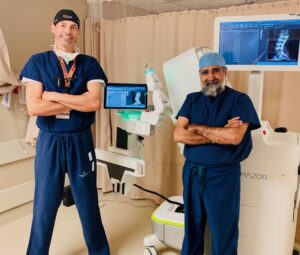Back and Spine Health
A Guide to Understanding Degenerative Disc Disease
According to the Spine Hospital at the Neurological Institute of New York, by the young age of 35, an estimated 30% of individuals will begin to display signs of disc degeneration.
By age 60, greater than 90% of the population will experience some level of disc degeneration. Although disc degeneration is a natural part of the aging process, often going unnoticed, degenerative disc disease is not.
Pain, numbness, reduced mobility and other symptoms of degenerative disc disease can range from annoyance to outright debilitating.
In this guide, we explore the different stages of degenerative disc disease to give you a better understanding of how it can progress over time. Have concerns? Contact a spine surgeon in Las Vegas, NV today.
What is Degenerative Disc Disease?
Degenerative disc disease ranks among the most common underlying causes of arm, neck, and back pain. Spinal discs separate each vertebrate of your spine, acting as a soft moveable cushion that reduces impact, stress and abrasion. Over time, these discs can become worn down, compressed, less flexible and prone to flattening or damage. This process narrows the spacing between vertebrate, putting increased pressure on the nerves that pass through them. This can result in pain, numbness and other symptoms. Similarly, a disc may bulge or rupture, further compressing nerves and resulting in tremendous pain.
What Are The Stages of Degenerative Disc Disease?
Degenerative disc disease is classified medically by stages, with stages progressing from 1-4 over time.
Stage One
During stage one of the disease, the discs and bony structure of your spine remain intact, with little sign of visible wear. However, during this stage additional stress on the discs may initiate a cascading effect, with your spine beginning to lose its normal support structure and/or curvature. As a result, posture, nerves and discs may experience undue stress and inflammation of surrounding tissues may be evident. Individuals at stage one may experience minor soreness and increasing pain as they struggle to maintain daily chores, work or athletic activities.
Stage Two
Some estimations demonstrate that by age 40, more than 75% of all men and women exhibit the signs of moderate disc degeneration. At this stage, frequent recurring or chronic pain and fatigue are common. Thinning of vertebral discs is also notable, although generally speaking little to no changes to the bony structure of the spine have yet to occur. Many signs of stage two degenerative disc progression are ignored as a ‘normal’ aches and pains associated with getting older.
Stage Three
Stage Three is marked by the start of structural changes to your spine. Sometimes the development of painful bony spurs may occur. The patient may notice adaptations to their posture to accommodate pain and in an effort to improve comfort. Pain and compression of nerves is often accompanied by frequent fatigue.
Stage Four
Stage Four of the disease is noted by a severe degradation of the discs, with little disc material left to provide cushioning and support of your spinal column. Significant changes to the vertebrae may be evident and will progress without treatment. At this stage, disc replacement surgery may be advised.

If you or a loved one have concerns about symptoms associated with degenerative disc disease, contact The Robotic Spine Institute of Las Vegas today at (888) 617-7463 or visit us at 7140 Smoke Ranch Rd, #150, Las Vegas, NV 89128. As leading Las Vegas spine surgeons, we are eager to learn more about your symptoms and how we can help.